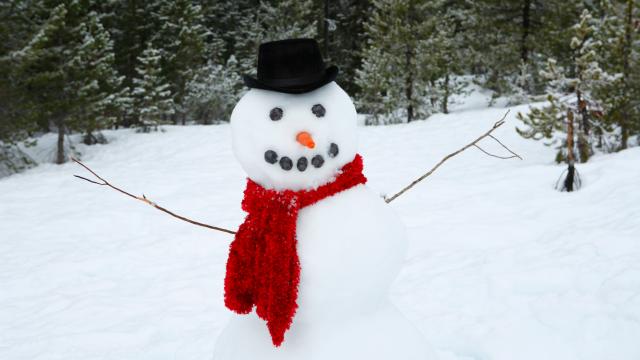True story: The title of the 8,011,991st Patent is “Apparatus for Facilitating the Construction of a Snow Man/Woman,” which certainly seems to imply that there’s a right way to build a snowman, snowwoman, or snowperson – when the weather allows for it.
But sometimes, no matter how much snow has fallen, you just can’t get your Frosty, Olaf or Leon (you know, the snazzy snowman in Elf) right. Its body crumbles, or its head falls off or one section refuses to grow, no matter how much snow you add, resulting in less of a snowman and more of a snow baby doll.
That’s where science comes in. Different snowfalls have different physical properties, and knowing a bit about the physics of your snowballs will help, too.
Snow matters
It’s not the size of the snowflake that matters so much as its moisture content. Snow comes in five categories based on the amount of free water relative to ice crystals, Dan Snowman (yes, that is his real name), a Rhode Island College in Providence physicist, told Smithsonian.com:
- Dry snow, which has zero per cent water
- Moist now, which has less than three per cent water
- Wet snow, which is made up of three to eight per cent water
- Very wet snow, made of eight to 15 per cent water
- Slush, which has more than 15 per cent water
Try to make a snowman with dry snow, and it won’t stick together. Use slush, and it’s like sculpting with water. The sweet spot you want is level two and three snow, Jordy Hendrikx, the director of the Snow and Avalanche Lab at Montana State University, told Smithsonian.com.
If you’re not sure how to classify that blanket of white in your backyard, turn to the temperature. The best snowfall for snowperson-building occurs right around the freezing point, 0 degrees (bonus points for not having to freeze your tuchus off in minus twelve-degree snowfall).
Location, location, location
Once you’ve determined that you’ve got the right raw material for your snow masterpiece, you need to find the right spot to build. Here are some considerations:
- You want level ground, but avoid asphalt — it absorbs sunlight, so your snowman is more likely to melt on your driveway.
- A flat spot near the bottom of a hill will keep your snow person cool and away from the sun’s rays, but it might end up as sledder roadkill.
- Your best bet, then, is on a flat portion of your yard, tucked close to the house to block the sun.
Shape matters
There’s a reason most of the snow people you see are made of spheres: Spheres are the best body shapes for a person made of snow, according to the Smithsonian:
Forming snowballs and packing the snow together exerts pressure on the ice crystals so that some melt during construction. “After melting, the water will crystallize once again, binding together the snowball,” Snowman notes.
Spheres will keep your snowman stable, and they’ll also help it stick around longer: Spheres melt slower than other shapes because there is a minimal area exposed to sunlight.
Snowman also points out that the standard rule of stacking snowballs —large at the base, medium-sized in the middle, small for the head — is the best way to keep your snow person upright. The lower the centre of mass (the point at which you could balance the snowman horizontally on your finger) is to the ground, the better.
Size matters
Students at West Virginia’s Bluefield State College even came up with an ideal ratio for your snowman: from bottom to top, 3:2:1 — but be sure to avoid making your snowballs too big.
There may be an upper limit to the size of the spheres, related to the water content of the snow. “As the snowball grows, it is more difficult to apply pressure to adequately pack,” says Snowman.
“This potentially results in an unstable structure for Frosty’s body parts and may result in catastrophic failure.”
So, this winter, if you’re lucky enough to find yourself in arm’s reach of some snow, use these tips to create the best snow person possible.
This article has been updated since its original publish date.

Comments